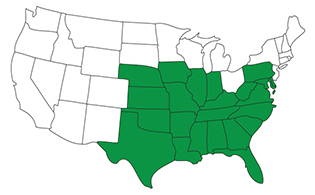
Carolina False Dandelion
Pyrrhopappus carolinianus
Carolina False Dandelion can be both a winter annual broadleaf weed or biennial broadleaf weed. It is also known as Carolina Desert-chicory or its scientific name, Pyrrhopappus carolinianus.
Identify

Rosette

Lobed

Lanceolate
Carolina False Dandelion is easy to identify, thanks to its vertically growing, branched, flowering stems. Its sharply pointed basal leaves form into a rosette pattern and alternate on its stems. Similar to Dandelion, this broadleaf weed produces bright-yellow flowers on the ends of its vertical, flowering stems. The seeds have a long stalk and a parachute of hairs at the top, forming a puff ball. Reproduction occurs by wind-dispersed seeds.
Life Cycle
This broadleaf weed is commonly found in woodlands, thickets, pastures, waste areas, thin areas of lawns and along roadsides and railroads. Carolina False Dandelion thrives throughout much of the southern and midwestern United States.

Control
Physical removal (i.e., pulling weeds) of Pyrrhopappus carolinianus is generally ineffective due to the risk of spreading the seeds to additional areas of your lawn and landscaping as well as the inability to fully remove the root system.




Facebook
X
Youtube
Copy Link
Email